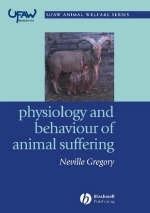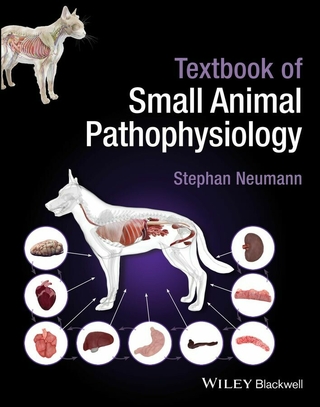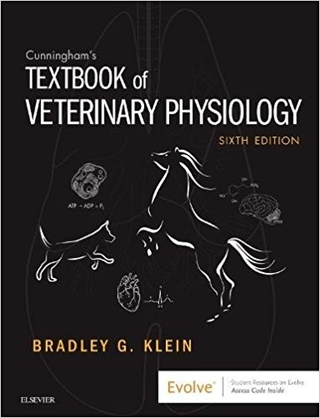
Physiology and Behaviour of Animal Suffering
Wiley-Blackwell (Verlag)
978-0-632-06468-7 (ISBN)
Suffering is a state of mind that is difficult to measure and analyse in human beings and considerably more so in animals. It is related to the environment in which we live and our physical and mental states. Understanding the physiology of suffering in animals is crucial in assessing animal welfare.
Written by an expert in applied welfare aspects of physiology, this book is the first to address the physiological aspects of suffering in animals. It explores the different causes of suffering – physical discomfort, thirst and hunger, the responses in the body that lead to suffering and it offers insight into how suffering can be managed.
The second book in a major new animal welfare series
Draws together information that is scattered across the literature
Written for the specialist and non-specialist alike
Includes colour pictures
This book is part of the UFAW/Wiley-Blackwell Animal Welfare Book Series. This major series of books produced in collaboration between UFAW (The Universities Federation for Animal Welfare), and Wiley-Blackwell provides an authoritative source of information on worldwide developments, current thinking and best practice in the field of animal welfare science and technology.
For details of all of the titles in the series see www.wiley.com/go/ufaw
Professor Neville Gregory is based at the Royal Veterinary College, Hawkshead, London.
Foreword ix
Preface xi
1 Introduction 1
1.1 What Is Suffering? 1
1.2 Why Worry about Animal Suffering? 1
1.3 When Can We Stop Worrying about Animal Suffering? 1
1.4 Recognising Suffering in Animals 7
1.5 Can Animals Go Mad? 8
1.6 What Constitutes Animal Suffering? 9
1.7 Conclusions 10
2 Stress 12
2.1 Stress Physiology 12
2.2 Stress-related Disorders 17
2.3 Restraint Stress 19
2.4 Stress-induced Analgesia 21
2.5 Stress-induced Seizures and Fits 21
3 Anxiety and Fear 22
3.1 Introduction 22
3.2 Anxiety 23
3.3 Experimental Models 25
3.4 Fear 26
3.5 Fright 28
3.6 Phobias 28
3.7 Panic 29
3.8 The Role of the Amygdala 30
3.9 Losing One’s Mother 31
4 Emotional Numbness and Deprivation 32
4.1 Anhedonia 32
4.2 Depression 33
4.3 Social isolation in the Newborn 34
4.4 Sensory Deprivation in Early Life 35
4.5 Sensory Deprivation in Later Life 36
4.6 Social Isolation and Barren Environments 36
4.7 Stereotypies and Neurotic Behaviours 37
4.8 Learned Helplessness 40
4.9 Post-traumatic Stress Disorder 40
4.10 Sleep Disorders 42
4.11 Weaning 44
4.12 Physiology of Emotions 45
5 Aggression, Overcrowding and Discomfort 46
5.1 Aggression 46
5.2 Overcrowding and Confinement 51
5.3 Discomfort 54
6 Exercise 56
6.1 Overexertion 56
6.2 Endurance Riding 57
6.3 Horse-racing Injuries 58
6.4 Greyhound Racing Injuries 61
6.5 Migration 63
7 Cold 64
7.1 Cold Discomfort and Pain 64
7.2 Skin Freezing and Chilblains 65
7.3 Hypothermia 66
7.4 Sensitivity to Cold 67
7.5 Hypothermia and Cold Survival 67
7.6 Cold in Combination with Starvation 69
7.7 Cold-induced Analgesia 70
8 Heat and Burns 72
8.1 Heat Stress 72
8.2 Heat Intolerance 73
8.3 Some Species Differences 74
8.4 Pain 75
8.5 Burns and Scalds 76
9 Thirst and Hunger 83
9.1 Thirst and Dehydration 83
9.2 Overhydration 86
9.3 Osmotic Stress 86
9.4 Hunger 87
9.5 Underfeeding 88
9.6 Emaciation 89
9.7 Inappropriate Diets 91
9.8 Forced Moulting 92
9.9 Force-feeding and Overeating 92
10 Pain 94
10.1 The Value of Pain 94
10.2 Pain Associated with Trauma 95
10.3 Ways in Which Animals Express Pain 99
10.4 Pain Pathways and Consciousness 102
10.5 Cortical Regions 106
10.6 Applied Neurology of Pain 107
10.7 Pain in a Given Context 119
11 Trauma 131
11.1 Injuries in Selected Body Regions and Tissues 131
11.2 Some Common Causes of Injury 133
11.3 Intended or Avoidable Causes of Trauma 142
11.4 Types of Injury 172
12 Sickness and Disease 183
12.1 Is Suffering an Inevitable Consequence of Being Ill? 183
12.2 Do the Behaviours Expressed During Sickness Serve a Purpose? 185
12.3 Cytokines and Sickness Behaviours 186
12.4 Cancer 187
12.5 Stress and Immune Function 188
12.6 Corticosteroid Therapy 191
12.7 Anaemia 191
12.8 Hazards of Improving Disease Control 191
12.9 Diseases Used for Controlling Pests 192
13 Digestive System 193
13.1 Nausea 193
13.2 Vomiting and Retching 193
13.3 Gut Pain 195
13.4 Diarrhoea 197
13.5 Gut Injuries 198
13.6 Stress and the Gut 198
13.7 Gastrointestinal Ulcers 199
14 Poisoning 201
14.1 Wartime Poisons 201
14.2 Environmental Toxicants 202
14.3 Vertebrate Pesticides 203
15 Respiratory System 207
15.1 Asphyxia 208
15.2 Breathlessness 209
15.3 Carbon Dioxide Inhalation 211
15.4 Drowning 212
15.5 Pulmonary Oedema 214
15.6 Hypoxia 215
15.7 Altitude Sickness 217
15.8 Decompression 218
15.9 Collapse of the Lung and Pneumothorax 219
15.10 Asthma and Allergies 219
15.11 Ammonia 220
15.12 Signs of Respiratory Distress 220
15.13 Agonal Gasping 222
16 Dying 223
16.1 Euthanasia 224
16.2 Decapitation 226
16.3 Religious Slaughter 227
16.4 Death from Brain Injury 227
16.5 Recognising Insensibility and Brain Death 229
References 232
Abbreviations 258
Index 260
| Erscheint lt. Verlag | 22.11.2004 |
|---|---|
| Verlagsort | Hoboken |
| Sprache | englisch |
| Maße | 173 x 244 mm |
| Gewicht | 621 g |
| Themenwelt | Veterinärmedizin ► Vorklinik ► Physiologie |
| ISBN-10 | 0-632-06468-4 / 0632064684 |
| ISBN-13 | 978-0-632-06468-7 / 9780632064687 |
| Zustand | Neuware |
| Haben Sie eine Frage zum Produkt? |
aus dem Bereich


